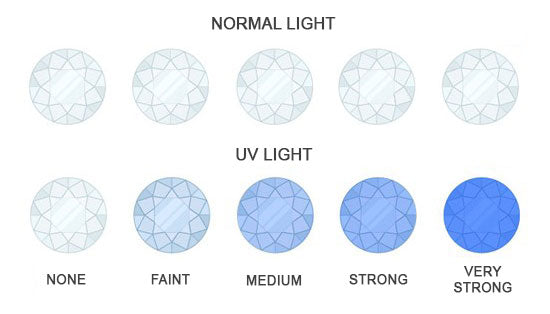7 Factors to Consider When Buying a Diamond
Shopping for a diamond can be overwhelming, but knowing the following 7 characteristics of diamonds will help you think like a professional jeweller and make it easier to decide which diamond to purchase.
The Diamond’s 4C’s
First let’s consider the 4 C’s, which are Carat, Colour, Clarity and Cut, and then we will introduce you to the basic diamond shapes, as well as fluorescence and diamond certificates.
1. Carat
Gemologists measure a diamond’s weight in metric carats. Each carat equals 200 milligrams or 0.2 grams. Each carat can be subdivided into 100 “points” with each point equaling one one-hundredth of a carat. This allows very precise measurements to the hundredth decimal place. Most of the diamonds that you will see as you shop will have their weight listed in carats or a fraction of a carat, but you might find an extra small diamond that has its weight listed in points. Be careful not to confuse diamond carat with diamond size.

2. Colour
Only a few diamonds are truly colourless. The rest of them come in varying shades of yellow and brown. After a diamond is mined, it is sent to a gem lab where gemologists grade its colour on a scale that begins with D (colourless) and ends with Z (light yellow). Colourless diamonds are most valuable and hence the most pricy. We usually advise to choose diamonds between D and I maximum. Learn more about the different diamond colours and their grade.

3. Clarity
As diamonds are formed far below the earth’s surface, they acquire internal inclusions and external blemishes. Clarity refers to the number, type and position of these imperfections. Diamond clarity is graded on a scale that begins with Loupe Clean (LC) and continues to Piqué 3 (P3). Check out our guide on choosing the right diamond clarity.

*Loupe Clean (LC) is also named Flawless/Internally Flawless, and P1, P2, P3 (Piqué) are also called I1, I2, I3 (Included) at GIA.
4. Cut
A diamond’s cut refers to all the tiny facets and angles that are cut into the gem to enhance its reflection of light. A poorly cut diamond is dull and lifeless, while a diamond with high-quality facets and angles interacts efficiently with light to create: Brightness – which is the reflection of white light, Fire – which is the scattering of light in all the colours of the rainbow and Scintillation or Sparkles – which are caused by light and dark patterns within the gem. The cut grade is divided into 3 parameters: Proportions, Symmetry, Polish. Each parameter is evaluated separately according to different quality grades: Excellent (EX), Very Good (VG), Good (G) or Fair (F). Learn why a diamond’s cut is so important when choosing a diamond.

The Diamond Shapes, Fluorescence and Certificates
5. Shapes
Diamonds come in various shapes. The round brilliant cut is the most common and most valuable diamond shape. Round diamonds are highly prized, because they have the most brilliance.
The remaining diamond shapes are called fancy shapes. Some of them, like the marquise, pear and heart, are actually modifications of the round brilliant cut, while the square or rectangular shapes, including the asscher, are step cuts. All fancy shaped diamonds have varying degrees of fire and scintillation. Explore our guide on the 7 most popular diamond shapes.

6. Fluorescence
A small fraction, approximately 25-30%, of diamonds give off a faint blue glow when they are exposed to the UV rays in sunlight. Although a diamond’s fluorescence is difficult to see with the naked eye, on some occasions, too much fluorescence makes the diamond look hazy.
If you want to know how much fluorescence a specific diamond has, look at its lab report. Gem labs rate diamonds with fluorescence as nil, slight, medium, or strong (according to the HRD Antwerp gem lab). At Beldiamond we usually advise to avoid fluorescence altogether.

7. Certificates
The safest way to purchase a diamond is to purchase one with a certificate issued by a reputable gem laboratory. The main gem labs are the Gemological Institute of America (GIA), Hoge Raad voor Diamant (HRD) and the International Gemological Institute (IGI).
Certificates guarantee a diamond’s quality by specifically listing its cut, colour, clarity and weight, as well as protect the investment of the buyer by helping the gem hold its value better over time. We advise to always buy a diamond with a certificate.


